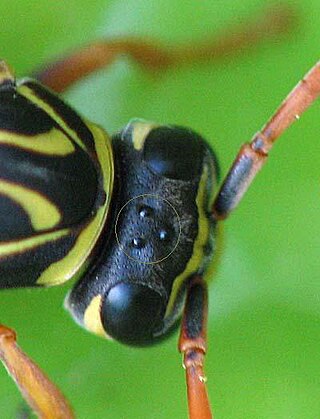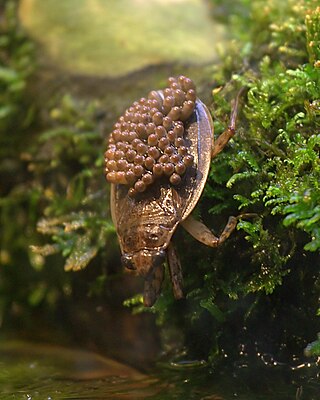
Beetles are insects that form the order Coleoptera, in the superorder Holometabola. Their front pair of wings are hardened into wing-cases, elytra, distinguishing them from most other insects. The Coleoptera, with about 400,000 described species, is the largest of all orders, constituting almost 40% of described insects and 25% of all known animal species; new species are discovered frequently, with estimates suggesting that there are between 0.9 and 2.1 million total species. Found in almost every habitat except the sea and the polar regions, they interact with their ecosystems in several ways: beetles often feed on plants and fungi, break down animal and plant debris, and eat other invertebrates. Some species are serious agricultural pests, such as the Colorado potato beetle, while others such as Coccinellidae eat aphids, scale insects, thrips, and other plant-sucking insects that damage crops.

Bifocals are eyeglasses with two distinct optical powers. Bifocals are commonly prescribed to people with presbyopia who also require a correction for myopia, hyperopia, and/or astigmatism.

A compound eye is a visual organ found in arthropods such as insects and crustaceans. It may consist of thousands of ommatidia, which are tiny independent photoreception units that consist of a cornea, lens, and photoreceptor cells which distinguish brightness and color. The image perceived by this arthropod eye is a combination of inputs from the numerous ommatidia, which are oriented to point in slightly different directions. Compared with single-aperture eyes, compound eyes have poor image resolution; however, they possess a very large view angle and the ability to detect fast movement and, in some cases, the polarization of light. Because a compound eye is made up of a collection of ommatidia, each with its own lens, light will enter each ommatidium instead of using a single entrance point. The individual light receptors behind each lens are then turned on and off due to a series of changes in the light intensity during movement or when an object is moving, creating a flicker-effect known as the flicker frequency, which is the rate at which the ommatidia are turned on and off– this facilitates faster reaction to movement; honey bees respond in 0.01s compared with 0.05s for humans.

The insects of the beetle family Chrysomelidae are commonly known as leaf beetles, and include over 37,000 species in more than 2,500 genera, making up one of the largest and most commonly encountered of all beetle families. Numerous subfamilies are recognized, but the precise taxonomy and systematics are likely to change with ongoing research.

The whirligig beetles are water beetles, comprising the family Gyrinidae that usually swim on the surface of the water if undisturbed, though they swim underwater when threatened. They get their common name from their habit of swimming rapidly in circles when alarmed, and are also notable for their divided eyes which are believed to enable them to see both above and below water. The family includes some 700 extant species worldwide, in 15 genera, plus a few fossil species. Most species are very similar in general appearance, though they vary in size from perhaps 3 mm to 18 mm in length. They tend to be flattened and rounded in cross section, in plain view as seen from above, and in longitudinal section. In fact their shape is a good first approximation to an ellipsoid, with legs and other appendages fitting closely into a streamlined surface. Whirligig beetles belong to the beetle suborder Adephaga, which also includes ground beetles and diving beetles.

The Haliplidae are a family of water beetles that swim using an alternating motion of the legs. They are therefore clumsy in water, and prefer to get around by crawling. The family consists of about 200 species in 5 genera, distributed wherever there is freshwater habitat; it is the only extant member of superfamily Haliploidea. They are also known as crawling water beetles or haliplids.

The Dytiscidae – based on the Greek dytikos (δυτικός), "able to dive" – are the predaceous diving beetles, a family of water beetles. They occur in virtually any freshwater habitat around the world, but a few species live among leaf litter. The adults of most are between 1 and 2.5 cm (0.4–1.0 in) long, though much variation is seen between species. The European Dytiscus latissimus and Brazilian Megadytes ducalis are the largest, reaching up to 4.5 cm (1.8 in) and 4.75 cm (1.9 in) respectively. In contrast, the smallest is likely the Australian Limbodessus atypicali of subterranean waters, which only is about 0.9 mm (0.035 in) long. Most are dark brown, blackish, or dark olive in color with golden highlights in some subfamilies. The larvae are commonly known as water tigers due to their voracious appetite. They have short, but sharp mandibles and immediately upon biting, they deliver digestive enzymes into prey to suck their liquefied remains. The family includes more than 4,000 described species in numerous genera.

A simple eye refers to a form of eye or an optical arrangement composed of a single lens and without an elaborate retina such as occurs in most vertebrates. In this sense "simple eye" is distinct from a multi-lensed "compound eye", and is not necessarily at all simple in the usual sense of the word.

Byrrhoidea is a superfamily of beetles belonging to Elateriformia that includes several families which are either aquatic or associated with a semi-aquatic habitat. Other than the superfamily Hydrophiloidea, most of the remaining Polyphagan beetles which are aquatic are in this superfamily.

Dytiscus latissimus is a large species of aquatic beetle in family Dytiscidae. It is native to Europe and considered threatened.

Acilius sulcatus is a species of water beetle in the family Dytiscidae. It is fairly large, with color variation shown throughout its range. Typically it is yellow and black.

Abedus is a genus of giant water bugs found in freshwater habitats in southern United States, Mexico and Central America. Sometimes called ferocious water bugs, these brown insects typically are between 2.3 and 4 cm (0.9–1.6 in) long, although A. immaculatus only is about 1.3–1.4 cm (0.51–0.55 in), making it the smallest North American belostomatid and possibly worthy of separation in its own genus. Otherwise the different Abedus species are very similar and can often only be separated with a microscope. They will bite in self-defense, which is painful but not dangerous.

Necrophages are organisms that obtain nutrients by consuming decomposing dead animal biomass, such as the muscle and soft tissue of carcasses and corpses. The term derives from Greek nekros, meaning 'dead', and phagein, meaning 'to eat.' Mainly, necrophages are species within the phylum Arthropoda; however, other animals, such as gastropods and Accipitrimorphae birds have been noted to engage in necrophagy.

Hydroporinae is a subfamily of predaceous diving beetles in the family Dytiscidae. There are at least 2,200 described species in Hydroporinae.

Eretes sticticus, the western erete, is a species of predaceous diving beetle in the family Dytiscidae. It is found in Africa, the Middle East, and the Americas from the southern United States to Peru. This species preys specifically on mosquito larvae in ponds and pools. They can kill up to all the instar larvae of the mosquito depending on size and density of the prey.
Thermonectus intermedius is a species of predaceous diving beetle in the family Dytiscidae. It is found in North America.

Dytiscus semisulcatus, the brown-bellied great diving beetle , is an aquatic diving beetle native to Europe and northern Asia, and is particularly common in England. It is a large dark red-brown or black beetle, that can fly and lives near water.

Cybister tripunctatus, is a species of predaceous diving beetle found in India, Andaman & Nicobar Islands, Sri Lanka, Afghanistan, Bangladesh, Myanmar, Nepal, Pakistan, Bhutan, China, Cyprus, Iran, Iraq, Japan, Kyrgyzstan, Mongolia, Russia, Syria, Tajikistan, Turkmenistan, Italy, Turkey, Uzbekistan and Europe.

Herophydrus musicus, is a species of predaceous diving beetle found in Asia and Europe.
Hydrovatus picipennis, is a species of predaceous diving beetle found in India, Sri Lanka, Indonesia, Philippines, China and Thailand.




















